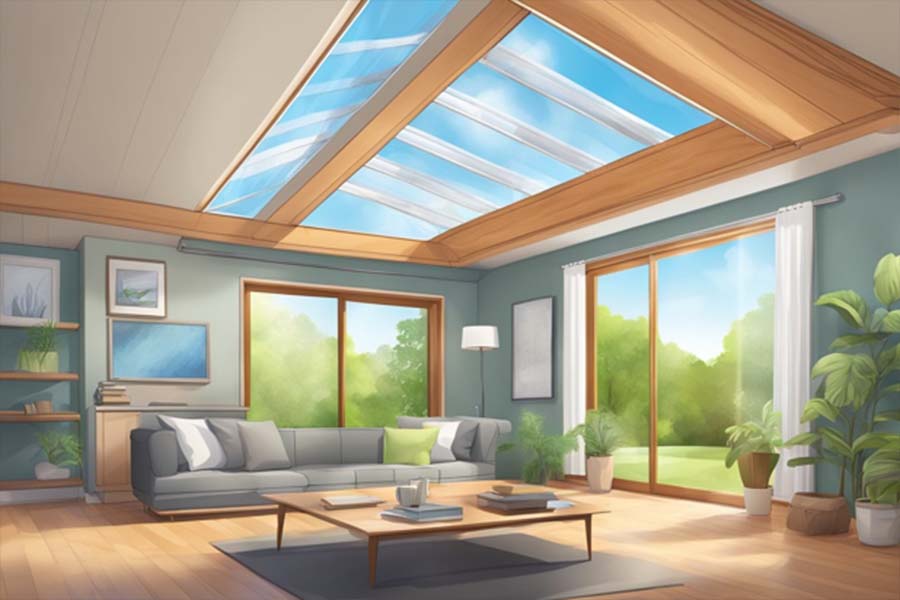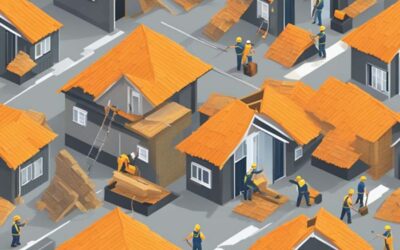Proper roof ventilation is essential for maintaining the longevity and comfort of a building. Without proper ventilation, a variety of issues can arise, including mold growth, increased energy costs, and even structural damage. In this article, we will explore the importance of roof ventilation and how it can benefit both residential and commercial buildings.
One of the primary benefits of roof ventilation is its ability to regulate the temperature inside a building. During the summer months, heat can build up in the attic, causing the entire building to become uncomfortably hot. This can lead to increased energy costs as air conditioning systems work harder to maintain a comfortable temperature. Proper ventilation allows hot air to escape, keeping the attic and the rest of the building cooler and more comfortable.
In addition to regulating temperature, roof ventilation also helps prevent moisture buildup. When warm, moist air from the interior of a building rises and meets a cool surface, such as the underside of a roof, condensation can occur. This can lead to mold growth, which not only damages the structure of a building but can also pose health risks to its occupants. Proper ventilation allows moisture to escape, preventing mold growth and maintaining a healthy indoor environment.
Fundamentals of Roof Ventilation
Ventilation Principles
Proper roof ventilation is essential for maintaining a comfortable and healthy living environment, as well as prolonging the lifespan of a roof. The fundamental principles of roof ventilation involve creating a continuous flow of air through the attic space, which helps to regulate temperature and moisture levels.
In warm climates, proper ventilation helps to prevent the buildup of heat and moisture, which can cause damage to the roof structure and shingles, as well as promote mold growth and decrease indoor air quality. In cold climates, proper ventilation helps to prevent ice damming, which occurs when warm air from the living space rises into the attic and melts snow on the roof, which then refreezes at the eaves.
There are several factors to consider when designing a roof ventilation system, including the size and shape of the attic space, the type of roofing material, and the climate zone. It is important to consult with a roofing professional to determine the best ventilation solution for a particular roof.
Types of Roof Vents
There are several types of roof vents that can be used to create a continuous flow of air through the attic space. Some of the most common types include:
- Ridge vents: Installed along the ridge of the roof, these vents allow hot air to escape from the attic space.
- Soffit vents: Installed in the eaves of the roof, these vents allow cool air to enter the attic space.
- Gable vents: Installed on the gable end of the roof, these vents allow hot air to escape from the attic space.
- Turbine vents: Installed on the roof, these vents use wind power to create a vacuum that pulls hot air out of the attic space.
The type and placement of vents will depend on the specific needs of the roof and the climate zone. It is important to ensure that there is a balanced system of intake and exhaust vents to create a continuous flow of air through the attic space.
Benefits of Proper Ventilation
Temperature Regulation
Proper roof ventilation helps to regulate the temperature inside a building. During hot summer months, heat can build up in an attic or roof space, making the rest of the building uncomfortable and even unbearable. With proper ventilation, hot air is allowed to escape, reducing the amount of heat that builds up in the roof space. This helps to keep the rest of the building cooler, making it more comfortable for occupants.
Moisture Control
Moisture can build up in a roof space due to a variety of reasons, including condensation, leaks, and high humidity levels. This can lead to the growth of mold and mildew, which can cause health problems and damage to the building. Proper ventilation helps to remove moisture from the roof space, reducing the risk of mold and mildew growth. It also helps to prevent damage to the roof structure, which can be costly to repair.
Energy Efficiency
Proper ventilation can also help to improve the energy efficiency of a building. During the winter months, warm air can rise and get trapped in the roof space, making the rest of the building feel colder. With proper ventilation, this warm air is allowed to escape, reducing the workload on heating systems and reducing energy costs. In the summer months, proper ventilation can reduce the workload on air conditioning systems, leading to further energy savings.
In conclusion, proper roof ventilation is essential for the longevity and comfort of a building. It provides a range of benefits, including temperature regulation, moisture control, and energy efficiency. By ensuring that a building has proper ventilation, occupants can enjoy a more comfortable and healthy living environment, while also reducing energy costs and extending the life of the building.
Installation and Maintenance
Installation Guidelines
Proper installation of roof ventilation systems is crucial to ensure optimal performance and longevity. Here are some general guidelines to follow:
- Choose the right type of ventilation system for your roof and climate. Consult with a professional to determine the best option for your specific needs.
- Install the ventilation system at the highest point of the roof to ensure maximum airflow.
- Ensure that the vents are evenly distributed throughout the roof to prevent hot spots and ensure proper ventilation.
- Use high-quality materials and follow manufacturer instructions for installation to ensure proper function and durability.
Maintenance Tips
Regular maintenance is necessary to ensure that your roof ventilation system continues to function properly. Here are some tips to keep in mind:
- Clean the vents regularly to prevent blockages caused by debris build-up.
- Inspect the vents for damage and replace any damaged components promptly.
- Check for leaks and ensure that all connections are secure.
- Monitor the system’s performance and make adjustments as necessary to ensure optimal airflow.
Common Ventilation Mistakes
Improper installation and maintenance can lead to ventilation issues and reduce the lifespan of your roof. Here are some common mistakes to avoid:
- Installing too few vents or placing them in the wrong location, which can lead to inadequate airflow and hot spots.
- Neglecting to clean the vents regularly, which can lead to blockages and reduced airflow.
- Using low-quality materials or failing to follow manufacturer instructions for installation, which can lead to premature failure.
- Failing to monitor the system’s performance and make adjustments as necessary to ensure optimal airflow.
By following these guidelines and avoiding common mistakes, you can ensure that your roof ventilation system provides optimal performance and longevity.
Impact on Roof Longevity
Preventing Roof Damage
Proper roof ventilation is essential for preventing damage to the roof caused by moisture buildup, especially in areas with high humidity or frequent rainfall. When moisture accumulates in the attic, it can cause the roof deck to warp, rot, or deteriorate, leading to costly repairs or even roof replacement. Additionally, moisture buildup can promote the growth of mold and mildew, which can pose health risks to occupants and compromise the structural integrity of the roof.
By ensuring adequate roof ventilation, homeowners can prevent damage to the roof caused by moisture buildup. Proper ventilation allows air to circulate freely through the attic, removing excess moisture and preventing the buildup of heat that can damage the roof deck.
Extending Roof Life
In addition to preventing damage, proper roof ventilation can also help extend the life of the roof. When a roof is exposed to high temperatures for extended periods, it can cause the shingles or other roofing materials to deteriorate, leading to premature failure. By allowing hot air to escape through the roof vents, proper ventilation can help regulate the temperature in the attic and prevent excessive heat buildup, thereby extending the life of the roof.
Moreover, proper ventilation can also prevent ice dams from forming on the roof during winter months. Ice dams occur when snow on the roof melts and then refreezes at the eaves, causing water to back up under the shingles and into the attic. This can cause damage to the roof deck and lead to leaks. By ensuring adequate ventilation, homeowners can prevent ice dams from forming and protect their roofs from damage.
In summary, proper roof ventilation is essential for preventing damage to the roof caused by moisture buildup and extending the life of the roof. Homeowners should consult with a professional roofing contractor to ensure that their roof is properly ventilated to maximize its longevity and maintain a comfortable living environment.
Comfort and Health Considerations
Indoor Air Quality
Proper roof ventilation is essential for maintaining good indoor air quality. Without it, the air inside your home can become stagnant and polluted, leading to a range of health problems. This is especially true in areas with high humidity or where there is a lot of moisture in the air.
When warm, moist air rises and gets trapped in your attic, it can create the perfect breeding ground for mold and mildew. These can release spores into the air that can cause respiratory problems, allergies, and other health issues. Proper ventilation helps to prevent this by allowing fresh air to circulate and keeping humidity levels in check.
Comfort Levels in Living Spaces
Roof ventilation is also important for maintaining comfortable living conditions. When your attic gets too hot, it can make the rest of your home feel uncomfortable as well. This is because heat rises, so if your attic is hot, it will radiate down into your living spaces.
Proper ventilation helps to prevent this by allowing hot air to escape and cool air to enter. This can help to keep your home at a comfortable temperature year-round, reducing the need for air conditioning in the summer and heating in the winter.
In addition, proper ventilation can also help to reduce moisture levels in your home. This can help to prevent problems like mold and mildew, as well as reducing the risk of damage to your home’s structure from rot and decay.
Overall, proper roof ventilation is essential for maintaining good indoor air quality and comfortable living conditions. By ensuring that your home has adequate ventilation, you can help to protect your health and prolong the life of your home.
Building Codes and Standards
Local Regulations
Roof ventilation requirements vary depending on the location and the building codes enforced by local authorities. These codes are designed to ensure the safety and comfort of building occupants. The International Residential Code (IRC) and International Building Code (IBC) provide guidelines for minimum ventilation requirements.
For example, in the United States, the IRC requires a minimum of 1 square foot of ventilation for every 150 square feet of attic space. This can be achieved through a combination of soffit vents, ridge vents, and gable vents. In addition, some states and municipalities may have additional requirements based on climate and other factors.
It is important to consult with local authorities to ensure compliance with regulations and to avoid potential fines or legal issues.
Industry Best Practices
In addition to local regulations, there are industry best practices for roof ventilation that can help ensure maximum comfort and longevity of a roof. These practices include:
- Using a balanced ventilation system that includes both intake and exhaust vents to ensure proper air circulation.
- Installing vents at the highest point of the roof to allow hot air to escape.
- Using vents with a mesh screen to prevent pests and debris from entering the attic space.
- Ensuring that insulation does not block vents, as this can restrict airflow and reduce the effectiveness of the ventilation system.
Following these best practices can improve the performance of the ventilation system and extend the life of the roof, while also providing a more comfortable living environment for occupants.





0 Comments